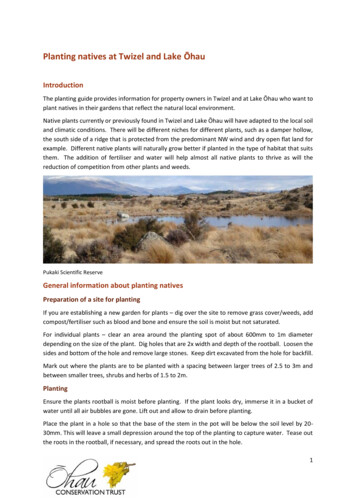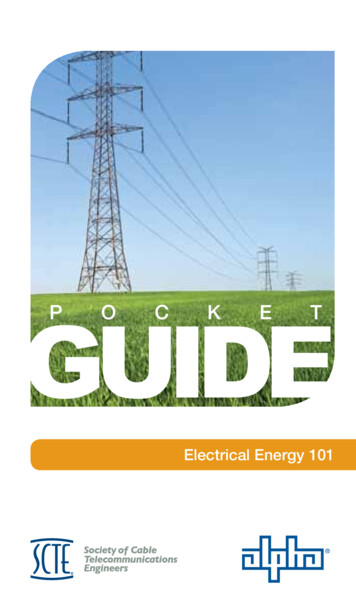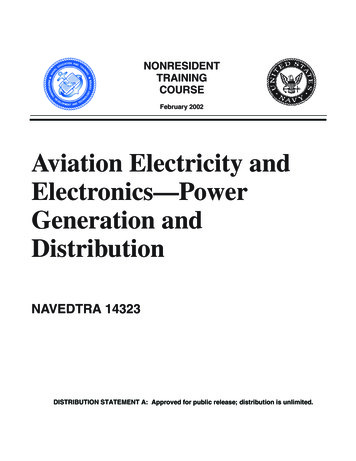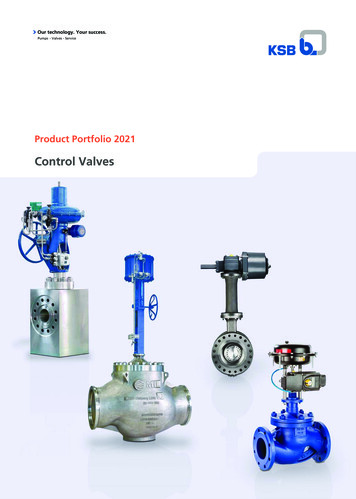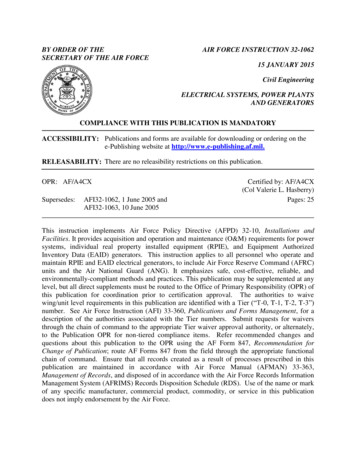
Transcription
BY ORDER OF THESECRETARY OF THE AIR FORCEAIR FORCE INSTRUCTION 32-106215 JANUARY 2015Civil EngineeringELECTRICAL SYSTEMS, POWER PLANTSAND GENERATORSCOMPLIANCE WITH THIS PUBLICATION IS MANDATORYACCESSIBILITY: Publications and forms are available for downloading or ordering on thee-Publishing website at http://www.e-publishing.af.mil.RELEASABILITY: There are no releasibility restrictions on this publication.OPR: AF/A4CXSupersedes:AFI32-1062, 1 June 2005 andAFI32-1063, 10 June 2005Certified by: AF/A4CX(Col Valerie L. Hasberry)Pages: 25This instruction implements Air Force Policy Directive (AFPD) 32-10, Installations andFacilities. It provides acquisition and operation and maintenance (O&M) requirements for powersystems, individual real property installed equipment (RPIE), and Equipment AuthorizedInventory Data (EAID) generators. This instruction applies to all personnel who operate andmaintain RPIE and EAID electrical generators, to include Air Force Reserve Command (AFRC)units and the Air National Guard (ANG). It emphasizes safe, cost-effective, reliable, andenvironmentally-compliant methods and practices. This publication may be supplemented at anylevel, but all direct supplements must be routed to the Office of Primary Responsibility (OPR) ofthis publication for coordination prior to certification approval. The authorities to waivewing/unit level requirements in this publication are identified with a Tier (“T-0, T-1, T-2, T-3”)number. See Air Force Instruction (AFI) 33-360, Publications and Forms Management, for adescription of the authorities associated with the Tier numbers. Submit requests for waiversthrough the chain of command to the appropriate Tier waiver approval authority, or alternately,to the Publication OPR for non-tiered compliance items. Refer recommended changes andquestions about this publication to the OPR using the AF Form 847, Recommendation forChange of Publication; route AF Forms 847 from the field through the appropriate functionalchain of command. Ensure that all records created as a result of processes prescribed in thispublication are maintained in accordance with Air Force Manual (AFMAN) 33-363,Management of Records, and disposed of in accordance with the Air Force Records InformationManagement System (AFRIMS) Records Disposition Schedule (RDS). Use of the name or markof any specific manufacturer, commercial product, commodity, or service in this publicationdoes not imply endorsement by the Air Force.
2AFI32-1062 15 JANUARY 2015SUMMARY OF CHANGESThis document is substantially revised and must be completely reviewed. This revision ofAFI 32-1062 also replaces AFI 32-1063, Electrical Power Systems. AF Form 487, GeneratorOperating Log (Inspection and Testing), has been updated and must be used for all generatorsinstalled after the publication date of this AFI. Generator authorization, classification, andvalidation have been consolidated in this revision. In accordance with the Director of CivilEngineers’ memorandum for “Authorization and Size Validation of Emergency and StandbyGenerators,” dated 1 April 2013, existing facilities with standby generators (RPIE or EAID)must be vetted through the generator authorization and classification process. New andreplacement generators require Air Force Civil Engineer Center (AFCEC) authorization,classification, and design approval (paragraph 1.1). Authorization and classification must beobtained in advance of design approval (paragraph 6.1). Revalidation of facilities authorizedstandby generators must be conducted every five years (paragraphs 1.4.6, 9.1). A newauthorization request is required for facilities with relevant changes to mission requirements ormodifications to the electrical system (paragraph 9.1). Generator authorizations will be assignedby individual facility. Facilities with multiple generators must have a single authorization for allstandby generators attached to the facility (paragraph 2.2).1.RESPONSIBILITIES. .32.AUTHORIZATION AND CLASSIFICATION OF GENERATORS. .73.AUTHORIZATION AND CLASSIFICATION OF FACILITIES. .84.ACCOUNTING FOR GENERATORS. .105.DOCUMENTATION AND RECORDS. .106.GENERATOR DESIGN AND INSTALLATION, AND EPA REQUIREMENTS.107.RPIE GENERATOR AND ATS TESTING AND INSPECTIONS. .138.REPORTING RPIE GENERATORS. .139.FIVE-YEAR REVALIDATION OF GENERATOR AUTHORIZATIONS. .1310.PRIME GENERATOR REQUIREMENTS. .1411.POWER CONDITIONING AND CONTINUATION INTERFACINGEQUIPMENT (PCCIE). .14Attachment 1—GLOSSARY OF REFERENCES AND SUPPORTING INFORMATION15Attachment 2—NEW AND REPLACEMENT GENERATOR AUTHORIZATION ANDDESIGN TEMPLATES20Attachment 3—EXISTING GENERATOR AUTHORIZATION AND DESIGN SIZINGTEMPLATE24
AFI32-1062 15 JANUARY 201531. RESPONSIBILITIES.1.1. Air Force Director of Civil Engineers (AF/A4C). Establishes policies for electricalsystems, power plants and generators.1.2. Air Force Civil Engineer Center (AFCEC). (T-1)1.2.1. Director, AFCEC Operations (AFCEC/CO), or designee, is the approval authorityfor generator authorization, design, and classification to include Critical OperationsPower Systems (COPS).1.2.2. AFCEC/CO is the approval authority for five-year revalidation of generatorauthorizations (see paragraph 9.1) and the use of generators for prime power orcogeneration.1.2.3. Chief, AFCEC Mechanical/Electrical Branch (AFCEC/COM), maintains masterlist of RPIE generators available for relocation, as compiled from the Major Commands(MAJCOMs) (see paragraph 1.2.1.2).1.2.4. Director, AFCEC Environmental (AFCEC/CZ), provides guidance regarding localemission restrictions, spill containment, and fuel tank inspection requirements.1.2.5. Director, AFCEC Energy (AFCEC/CN), reviews and coordinates on use ofgenerators for co-generation and Prime Power.1.2.6. Director, AFCEC Facility Engineering (AFCEC/CF), submits authorization anddesign approval requests to AFCEC/CO when projects are programmed withoutgenerator authorization.1.3. MAJCOM.1.3.1. MAJCOM Senior Engineer.1.3.1.1. MAJCOM Senior Engineer may delegate the following tasks (may not bedelegated below the MAJCOM).1.3.1.2. Reviews and coordinates on generator authorization and design requests orrecommend alternative for approval and submit requests to AFCEC/CO, ordisapprove with no further action.1.3.1.3. Reviews annual RPIE generator inventory reports and provide AFCEC/COMCivil Engineer Maintenance, Inspection, and Repair Team (CEMIRT) a list ofgenerators that are oversized, available for relocation, and cannot be redistributedwithin their command (see paragraph 8.4).1.3.1.4. Coordinates the five-year revalidation of generator authorizations withAFCEC/CO and forward validation reports to AFCEC/COSM by 1 October of thereporting year (see paragraph 9).1.3.1.5. Coordinates prime and cogeneration requests for utility tariff control throughAFCEC/CN (information copy to AFCEC/COSM).1.3.1.6. Ensure Base Civil Engineers (BCEs) develops written prioritized refuelingplans and requirements to support EAID and RPIE generator operation duringextended power outages of not less than seven days.
4AFI32-1062 15 JANUARY 20151.3.2. Vice Commanders (MAJCOM/CVs). Approves deviations for Semiannual FullSystem Testing, per paragraph 7.2.1.4. Installation Commander (or Equivalent). Approves deviations from manufacturerservice intervals. (T-1)1.5. BCE.1.5.1. Real Property Electrical Power Systems. The BCE provides, operates, andmaintains all real property electrical power systems and equipment, including EAIDequipment assigned to the BCE and RPIE items, with the exception of units supportingmissile systems or special-use tenant generators lacking a signed memorandum ofagreement (MOA). The BCE is responsible for operating and maintaining other realproperty and RPIE electrical systems (as applicable to each installation), including: (T-1)1.5.1.1. Controls, sensors, and alarm circuits needed for operation of real propertyfacilities, such as tank liquid level sensors and alarms.1.5.1.2. Fire alarm systems.1.5.1.3. Mass notification systems.1.5.1.4. Facility-integrated photovoltaic panels, arrays, and components.1.5.1.5. Electric and hybrid vehicle charging stations.1.5.1.6. Joint-Services Interior Intrusion Detection Systems (J-SIIDS).1.5.1.7. Electrical heating and air-conditioning systems using equipment similar toRPIE.1.5.1.8. Electrical systems temporarily deployed during exercises or contingency orwartime operations, or systems permanently assigned to an installation.1.5.1.9. Systems for utility plant management and distribution, such as energymanagement and control systems, which include supervisory control and dataacquisition systems and utility monitoring and control systems. The BCE obtainsadvance written approval from AFCEC/COSM to install any generator securitydevice, such as those used to mitigate electrical system vulnerability.1.5.2. Special-Use/Tenant Facility Systems. (T-1) The BCE maintains and testselectrical power systems at special-use or tenant facilities in accordance with Air Forcestandards for RPIE and equipment typically assigned to the CE squadron. Usingorganizations are responsible for operator-level maintenance of equipment supplyingpower exclusively to these facilities. Real property accountability for equipmentsupplying power to a special-use facility or tenant organization resides with the BCE.The BCE ensures required MOAs are established; that they address reimbursable/nonreimbursable expenses and requests for additional levels of maintenance; and theyreceive Judge Advocate review. The BCE has no maintenance responsibility forelectrical equipment that is not on the real property record or CE allowance standard andhas no MOA in place.
AFI32-1062 15 JANUARY 201551.5.2.1. The BCE will review and approve non-RPIE generator connectionsrequested by tenant organizations through the work order process per paragraph 1.8.(T-1)1.5.2.2. Defense Logistics Agency (DLA) capitalized real property and generatoroperation and maintenance that is funded through the DLA Sustainment, Restorationand Modernization (SRM) process is not a BCE responsibility without a MOA inplace. If a MOA is in place, the terms of the MOA will determine BCE responsibility.(T-1)1.5.3. Technical Documentation. (T-1) The BCE develops and maintains as-builtelectrical system drawings, operating procedures, schematics, and manufacturer O&Mmanuals.1.5.4. Generator Authorization, Design, and Classification. The BCE: (T-1)1.5.4.1. Develops and coordinates authorization, and design requests through theMAJCOM Senior Engineer to AFCEC for authorization and approval for RPIE andBCE-owned EAID generators, including generators procured with militaryconstruction (MILCON), O&M, SRM, DLA, or other funding. Exception: Developsand coordinates requests for generators serving dental and medical facilities throughthe medical field operating agency. (See memorandum templates in Attachments 2and 3, or fillable forms located on the Air Force Portal, AFCEC cssaf/USAF/ep/contentView.do?contentType EDITORIAL&contentId c2D8EB9D63C49E8B4013C86DBD2091008&channelPageId s2D8EB9D637283B5601377B2CE4030666&programId t2D8EB9D6386BFB8B01394F5729351F521.5.4.2. Maintains authorizations in the generator record.1.5.5. Generator Inventory. The BCE: (T-1)1.5.5.1. Conducts an annual inventory of all CE-operated and maintained RPIE andEAID generators by 1 August each year, including generators that are replacementeligible, and forwards a copy to the MAJCOM Senior Engineer.1.5.5.2. For RPIE generator accountability, reconciles the inventory with realproperty records; for EAID generators, with Custodian Authorization and CustodyReceipt Listing records.1.5.5.3. Includes generator classification and all generator data in each generatorrecord, in accordance with AF Form 487.1.5.6. Five-Year Validation of Authorizations. The BCE will conduct a validation ofgenerator authorizations every five years to identify changes to mission or electricalsystem configurations and will forward validation reports to the MAJCOM SeniorEngineer for revalidation (see paragraph 9). (T-1)1.5.7. Compliance with Federal Regulations. The BCE ensures compliance withapplicable provisions of 40 Code of Federal Regulations (CFR), Part 63 Subpart ZZZZ(all stationary prime power generators), 40 CFR Part 60 Subpart JJJJ (all stationary SparkIgnition (SI) generators), 40 CFR Part 60 Subpart IIII (all stationary CompressionIgnition (CI) generators), and 40 CFR Part 89 (portable diesel generators). Depending on
6AFI32-1062 15 JANUARY 2015generator location and age, operation and maintenance of generators in accordance withthe manufacturer's written instructions or procedures may be required. (T-0) Note: CFRterminology is unique and conflicts with National Fire Protection Association (NFPA)terminology and this AFI. CFR definitions are used for the sole purpose of applying CFRrequirements and are not used for classification purposes of the NFPA or this AFI.1.5.8. Refueling Plans. The BCE develops written prioritized refueling plans andrequirements to support EAID and RPIE generator operation and other generatoroperation identified within an approved MOA during extended power outages of not lessthan seven days. The BCE forwards a copy of the plans, together with the annualgenerator inventory, to the MAJCOM Senior Engineer. (T-1)1.5.9. Parallel System Operation. The BCE ensures: (T-1)1.5.9.1. EAID or RPIE generators or any generator owned by another agency will notoperate in parallel with any real property electrical system (i.e., transformer,switchgear, or utility) unless authorized by AFCEC/CO. (Exception: AutomaticTransfer Switches [ATSs] with momentary closed-transition transfer are permitted).1.5.9.2. Variable renewable energy sources do not operate in parallel with missioncritical generation.1.5.9.3. An interconnection agreement is in place when integrating utility-suppliedenergy into the installation electrical distribution system.1.5.9.4. Any distributed resource operating in parallel with installation electricalsystems complies with Institute of Electrical and Electronics Engineers (IEEE) 1547,Standard for Interconnecting Distributed Resources with Electrical Power Systems,and National Electrical Code (NEC) Articles 690 and 705, to ensure adequateprotection and separation from facility power systems during outages.1.5.10. Safety. The BCE:1.5.10.1. Establishes a requirement for an onsite fire extinguisher near the generatorin accordance with AFI 91-203, Air Force Consolidated Occupational SafetyInstruction. (T-1)1.5.10.2. Complies with safety codes and standards to ensure compliance withcurrent electrical safe work practices in accordance with 29 CFR 1910. (T-0)1.6. Installation Management Flights (Facility Manager for ANG). InstallationManagement Flights must coordinate with the BCE on generator installations and relocationsto ensure compliance with regulations.1.7. Facility Managers. (T-1)1.7.1. Verify proper function of all building equipment and systems during generatorfunctional testing using facility load; sign the AF Form 487 following the semi-annualgenerator test.1.7.2. Maintain and post next to the generator a list of personnel trained to operatefacility generators.
AFI32-1062 15 JANUARY 201571.7.3. Initiate and obtain MAJCOM/CV approval for extending the semiannual generatortesting, per paragraph 7.2.1.7.4. Provide an organizational memorandum for record for facility electrical systemtesting and maintenance that is deferred for more than 6 months. Consult the installationStaff Judge Advocate on associated potential safety, environmental, and operational risks.1.8. Tenant Organizations. Tenant organizations will submit a work request for anygenerator system that will be connected to real property, and establish an MOA with the BCEfor the operation and maintenance of the generator on a reimbursable basis. (T-1)2. AUTHORIZATION AND CLASSIFICATION OF GENERATORS.2.1. AFCEC/CO may authorize the use of generators for prime power or cogeneration on acase-by-case basis. When submitting a request for cogeneration within the area electricalpower system (EPS), the BCE must demonstrate that the system complies with IEEE 1547,and must negotiate an interconnection agreement with the area EPS (utility) supplier. (T-1)2.2. Only dedicated standby generators may be authorized to support mission-essentialfunctions. (T-1) Generators authorized to support mission-essential functions will beinstalled and connected to provide power only to mission-essential functions within a singlefacility in the event there is a loss of commercial power. (T-1) Using one standby system tosupport multiple facilities is not authorized due to simultaneous risk to multiple missions. (T1) If unique circumstances exist where one standby system is required to support multiplefacilities, an authorization request must be submitted to AFCEC/CO for approval. (T-1)2.3. Three types of generators may be authorized: RPIE; EAID; and other (described inparagraphs 2.3.1 through 2.3.3). (T-1)2.3.1. RPIE Generators. RPIE generators support mission-critical functions wherecontrolled shut-down or delayed power restoration is unacceptable. They may beauthorized for missions requiring immediate power restoration, uninterrupted power, orsupport for emergency systems as defined in NEC Article 700. (T-1) RPIE generatorsare classified as “Emergency,” “COPS,” Other Permanently Installed,” or “Petroleum,Oils, and Lubricants (POL)/Fuels” (see paragraphs 2.3.1.1 through 2.3.1.4).2.3.1.1. Emergency. This classification applies to life safety systems required tocomply with NEC Article 700. Emergency systems must also comply with NFPA110, Standard for Emergency and Standby Power Systems, Level 1 criteria. (T-0)2.3.1.2. COPS. The “COPS” classification applies to NEC Article 708 systems,which must comply with NFPA 110 Level 2 criteria. (T-0)2.3.1.3. Other Permanently Installed.The “Other Permanently Installed”classification applies to other mission-critical functions not designated as“Emergency” or “COPS.” These systems must comply with NEC, Article 701,“Legally Required Standby Systems,” and NPFA 110 Level 2 criteria. (T-0)2.3.1.4. POL/Fuels. This classification applies to Fuels Information Service Centers(Fuels Operation) and Type III, IV, and V hydrant fueling systems designed inaccordance with Department of Defense Standard Designs AW 78-24-28, PressurizedHydrant Fueling System, and AW 78-24-29, Pressurized Hot Fueling System, with amanual interlocked transfer switch. These systems must be sized to 50 percent of
8AFI32-1062 15 JANUARY 2015pumping capacity in the Continental United States and 100 percent of pumpingcapacity Outside Continental United States. (T-1)2.3.2. EAID Portable Units. EAID portable generators (trailer-mount or skid-mount) areclassified as either “POL/Fuels” or “Portable” (see paragraphs 2.3.2.1 through 2.3.2.2).(T-1)2.3.2.1. POL/Fuels. The EAID “POL/Fuels” classification applies to Types I and IIhydrant fueling systems, bulk fuel storage areas, non-hydrant operating storage areas,and vehicle fueling stations that must be prepositioned. (T-1) Detached fuels testinglabs not located in a fuels operations facility must have a generator connection plugand a manual transfer switch (MTS). (T-1)2.3.2.2. Portable. “Portable” generators may be authorized for mission-essentialfunctions where delayed power restoration is acceptable and portable generationdecreases simultaneous risk to the facility and generator.2.3.3. Other. Other generators (5 kW or less) not classified as RPIE or EAID are notaddressed in this AFI. These generators are unit owned and are not the responsibility ofthe BCE to maintain, test or operate.3. AUTHORIZATION AND CLASSIFICATION OF FACILITIES.3.1. Facilities listed in paragraphs 3.1.1 through 3.1.28 will be authorized and must beclassified as listed below, per the specified Unified Facility Criteria (UFC) or the generalcriteria in UFC 352001, Interior Electrical Systems. (T-0) Other facilities not addressed bythe UFC may be approved by AFCEC/CO. (T-1)3.1.1. Medical Healthcare and Ambulatory Care facilities (excludes medical businessoccupancies as defined by NFPA) in accordance with UFC 4-510-01, Design: MedicalMilitary Facilities (Emergency or Portable).3.1.2. Air navigation aids and facilities, and airfield lighting (COPS or OtherPermanently Installed).3.1.3. Mission/emergency-essential refrigerated storage rooms (Portable).3.1.4. POL storage and dispensing facilities (POL/Fuels RPIE or EAID).3.1.5. Mission-essential/critical utility plants (Other Permanently Installed).3.1.6. Critical sewage lift stations with low-level to high-level alarm duration less thanEAID deployment time (Other Permanently Installed).3.1.7. Typical sewage lift stations with adequate alarm notification to start pre-positionedgenerator (Portable or Other Permanently Installed when required by local laws).3.1.8. CE control centers (Portable or Other Permanently Installed).3.1.9. Mission-essential/critical communication facilities and telephone exchanges(Other Permanently Installed).3.1.10. Fire stations, including fire alarm, fire control, and radio equipment(Emergency).
AFI32-1062 15 JANUARY 201593.1.11. Mission-essential computer automated data processing facilities (OtherPermanently Installed).3.1.12. Air traffic control towers (COPS or Other Permanently Installed).3.1.13. Base weather stations (Other Permanently Installed or Portable).3.1.14. Surveillance and warning facilities (Other Permanently Installed).3.1.15. Primary command and control facilities (does not include headquarters facilitieswithout direct and essential command and control functions) (Other PermanentlyInstalled).3.1.16. Remotely piloted aircraft control pods that are hardwired into a RPIE facility(Other Permanently Installed or Portable).3.1.17. Munitions storage facilities (Other Permanently Installed, or Portable).3.1.18. Entry control points, security gates, and related security lighting systems(Portable).3.1.19. Aircraft and aircrew alert facilities (Other Permanently Installed).3.1.20. Law enforcement and security facilities (COPS, Other Permanently Installed, orPortable).3.1.21. Emergency operations centers in accordance with UFC 4-141-04, EmergencyOperations Center Planning and Design (Other Permanently Installed).3.1.22. Mission, property, and life support facilities at remote and not readily accessiblesites, such as split-site aircraft warning and surveillance installations (Other PermanentlyInstalled).3.1.23. One dining facility per installation or geographic location (Other PermanentlyInstalled or Portable).3.1.24. Industrial facilities that have noxious fumes requiring removal (provide powerfor the exhaust system only; in the case of an aircraft corrosion control facility, alsoprovide power to the hangar doors in accordance with UFC 4-211-02, Aircraft CorrosionControl and Paint Facilities) (Emergency) (Aircraft fuel cell repair facilities are notauthorized emergency or standby power).3.1.25. Readiness facilities relying on electrical power to support tactical or missionessential operations (Other Permanently Installed).3.1.26. Intelligence processing facilities providing mission-essential support to combatand contingency tactical missions (Other Permanently Installed).3.1.27. Simulation or materials laboratories where continuous power is needed forhuman safety or to maintain low-tolerance temperature ( 5 degrees Fahrenheit) andhumidity ( 5 percent) control to avoid catastrophic consequences. (Other PermanentlyInstalled).3.1.28. Emergency lighting, elevators, fire alarms, security systems, or other life safetyequipment within high-occupancy buildings or places of assembly of 1,000 or morepeople, for safely moving people out (Emergency).
10AFI32-1062 15 JANUARY 20154. ACCOUNTING FOR GENERATORS.4.1. RPIE Generators. (T-1) Notify the real property office if these generators aretemporarily or permanently relocated from one facility to another. Document and accountfor all RPIE generators awaiting installation in the appropriate work order documents. Forexcess generators and associated equipment (i.e., automatic transfer switches), requestMAJCOM review and disposition instructions before removing the generator and associatedequipment from a RPIE facility. After removing a generator, account for it on Department ofDefense (DD) Form 1149, Requisition and Invoice/Shipping Document, if the generator isshipped to another base or to the CEMIRT. If the generator is turned in to the DefenseReutilization and Marketing Office, account for it on DD Form 1348-1A, IssueRelease/Receipt Document.4.2. EAID Generators. (T-1) EAID generators are listed in Allowance Standard (AS),requisitioned from Warner Robins Air Force Life Cycle Management Center(AFLCMC/WNZEC), 235 Byron Street (Bldg 300-West Wing, Bay D), Robins AFB, GA31098-1647, DSN 472-1640, Comm (478) 222-1640, and accounted for by Base Supply andAFLCMC/WNZEC. EAID units must be reclassified as RPIE, and coordinated with the ItemManager, AFLCMC/WNZEC when they no longer meet the definition for an EAID or turnedin to Base Supply.4.3. AFLCMC/WNZEC. (T-1) Report excess EAID generators to AFLCMC/WNZEC.Any RPIE or commercial EAID generators that are no longer required or are inoperable mustbe identified to the MAJCOM for review and disposition coordination. Disposal of mobileelectric power (MEP) EAID generators must be first coordinated with the EAID ItemManager at AFLCMC/WNZEC. If generators are not required or needed byAFLCMC/WNZEC, they must be disposed of in the same manner as RPIE and commercialEAID generators.5. DOCUMENTATION AND RECORDS.5.1. Operations, maintenance, repair, and replacement of RPIE and EAID generators must bedocumented on the following forms and will become part of the shop record only: (T-1)5.1.1. AF Form 719, Historical Record - Diesel-Electric Generator and System, for thelife of the generator.5.1.2. AF Form 487, Generator Operating Log (Inspection and Testing), for three yearswithin the shop record.5.1.3. Generator authorization letter from AFCEC/COSM.5.1.4. Approved generator design from AFCEC/COSM (installed after 1 Nov 2011).5.1.5. Waivers or environmental permits with restrictions, if any.6. GENERATOR DESIGN AND INSTALLATION, AND EPA REQUIREMENTS.6.1. RPIE Generator Authorizations and Designs. (T-1) RPIE generator authorizationsand design approvals must be obtained from AFCEC/CO or its designee. Submit thegenerator authorization request during project initiation (programming) and submit thedesign approval request at the 65 percent design milestone. If electrical design changes aremade after the 65 percent design submittal, another design approval request is required.
AFI32-1062 15 JANUARY 201511Requests must be in accordance with the templates provided in Attachments 2 and 3, ordownloaded from the Air Force Portal, AFCEC Electrical Engineering site. Authorizationand approval memos become part of the generator permanent record.6.2. EAID Generator Authorizations. (T-1) EAID generator authorizations must beapproved in writing by AFCEC/CO or its designee. Submit generator authorization requestsduring project initiation (programming); design approvals are not required. Requests must besubmitted in accordance with the template provided in Attachment 2, or downloaded fromthe Air Force Portal AFCEC Electrical Engineering site. The approval memo becomes part ofthe generator permanent record.6.3. Partial Facility Generator Power. (T-1)When only a portion of a facility is authorizedgenerator power, that portion of the facility must be serviced by a separate subpanel fed fromthe generator and switched by either an MTS or ATS, depending on the mission of thefacility. A whole-building generator may be requested only when the authorized missionessential load is greater than 70 percent of the total facility load. For existing facilitieswithout segregated mission-essential subpanels, size replacement generators and transferswitches only for the authorized mission-essential load, and develop a plan for load-sheddingall non-essential loads.6.4. Generator Sizing. (T-1) Existing, new, or replacement EAID or RPIE generatorsystems must be sized to achieve greater than 50 percent rated load, and capable ofsupporting measured or calculated, starting, and step load as defined by a qualified, licensedelectrical design engineer or the senior electrical engineer in the unit for in-house designedprojects. For existing generator replacements, load data supporting generator selection mustbe provided; acceptable forms of support data would include the monthly load data recordedon AF Form 487, for the past 12 months; meter data showing average load and peak over athree-day period during a period of full operation; or accurate facility one-lines with allassociated panel schedules, equipment schedules, and load calculations.6.5. Load Banks. (T1) For generator installations sized 250 kW and higher, the designmust include provision for portable load bank/generator connection at the ATS or distributionequipment (not at the generator). The connection must be sized for the generator kW rating.Reference UFC 3-540-01, Engine-Driven Generator Systems for Backup PowerApplications, for additional guidance.6.6. Mission Uninterruptable Power Supplies (UPS). (T-1) Mission UPSs ins
Generator Inventory. The BCE: (T-1) 1.5.5.1. Conducts an annual inventory of all CE-operated and maintained RPIE and EAID generators by 1 August each year, including generators that are replacement-eligible, and forwards a copy to the MAJCOM Senior Engineer. 1.5.5.2. For RPIE generator accountability, reconciles the inventory with real

